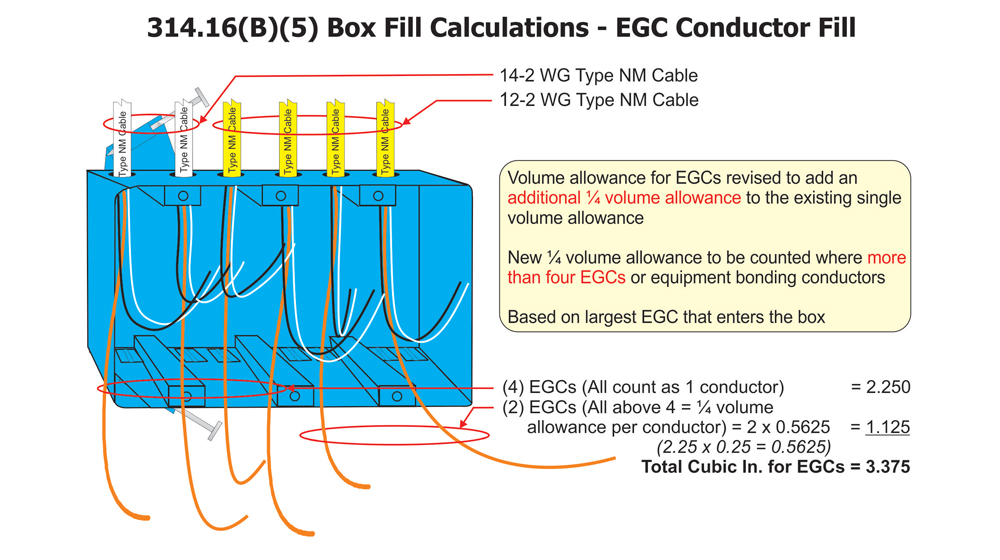314.16(B)(5) Box Fill Calculation Revised. Volume Allowance for EGCs and Equipment Bonding Jumpers
Change Summary
- An additional ¼ volume allowance is now required to be added to the existing volume allowance of a single conductor volume allowance based on the largest equipment grounding conductor or equipment bonding jumper entering the box. This new ¼ volume allowance will be counted for each EGC installed in the box for more than four EGCs or equipment bonding conductors. This change eliminates the need to specifically address the EGCs for isolated ground receptacles permitted by 250.146(D).
| NEC® Text |
|---|
|
314.16 Number of Conductors in Outlet, Device, and Junction Boxes, and Conduit Bodies. Material taken from the National Electric Code® is reprinted with permission from NFPA 70®, 2020 edition. |
Expert Analysis
Volume of a box is the total volume in cubic millimeters or cubic inches of the assembled sections. This total volume (space) determines the number and size of conductors and wiring devices permitted to be contained in the box. Conductors, internal clamps, support fittings, and devices such as switches and receptacles take up space within the box. So, the Code assigns to each conductor, clamp, support fitting, device and equipment grounding conductor an associated volume allowance. This volume allowance is listed in cubic inches or cubic centimeters. Table 314.16(B) list the volume allowance as a function of conductor size. For example, according to Table 314.16(B), each 12 AWG conductor in a box takes up 36.9 cm3 (2.25 in.3) of free space within that box. When preforming a box fill calculation, the volume allowance for each conductor, clamp, support fitting, device, and equipment grounding conductor is added together. The box must have a volume that equals or exceeds the total volume required for the contained items.

A single volume allowance has been required for all equipment grounding conductors within a box since the 1971 NEC. This single volume deduction was based on the largest equipment grounding conductor or equipment bonding jumpers present in the box. This was for all equipment grounding conductors or equipment bonding jumper regardless of the number of equipment grounding conductors or equipment bonding jumpers installed.
For the 2020 NEC, the single volume allowance or deduction will apply to the first four equipment grounding conductors or equipment bonding jumpers. Any equipment grounding conductor or equipment bonding jumper installed above four will require an additional ¼ volume allowance to the existing volume allowance of a single conductor volume allowance based on the largest equipment grounding conductor or equipment bonding jumper entering the box. In multiple gang boxes, taking only one volume allowance based on the largest EGC is not adequate in many cases resulting in significant undue crowding of conductors and not enough free space to allow heat to dissipate from the contained conductors. This change also eliminates the need to specifically address the equipment grounding conductors for isolated ground receptacles permitted by 250.146(D).
This revision to the required free space in a box for equipment grounding conductors and equipment bonding jumpers will address is the issue of complying with both 314.16(B)(5) and 300.14. The requirements of 300.14 generally require at least 150 mm (6 in.) of free conductor, measured from the point in the box where it emerges from its raceway or cable sheath, to be provided at each outlet, junction, and switch point for splices or the connection of luminaires or devices. Requiring all equipment grounding conductors to meet 300.14 (at least 150 mm (6 in.) of free conductor for each conductor) and applying only a single volume allowance was problematic in past editions of the Code in device boxes with multiple equipment grounding conductors and often resulted in overcrowded conditions.







